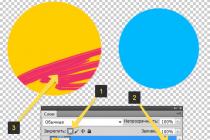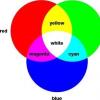And this video is a must watch if you want to have some fun:
Design, dimensions, weight
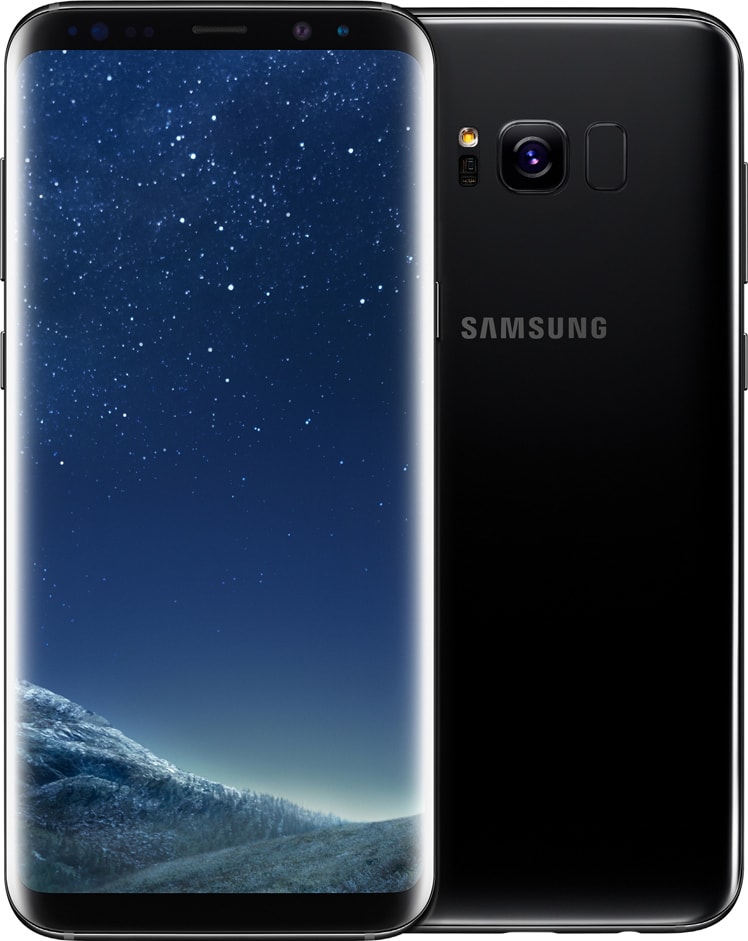

The novelty has a premium look. Curved screen, minimal bezels. This design looks fresh. Of course, the outlines of last year's flagship are recognizable, but this huge display, which occupies almost the entire front panel, and the absence of physical buttons on the front side, make the design fundamentally different.
The freshness of the new design is already in the fact that the model looks transparent, weightless, because the heaviness is given mainly by the frames.
The Korean company uses the slogan for this model: "Smartphone without borders." This ambiguity of the slogan defines this device really well.
This phone will really stand out. Looks expensive and stylish. Not to be confused with cheaper models.
S8 dimensions (in mm): 148.9 × 68.1 × 8.
Dimensions S8+ (in mm): 159.5 × 73.4 × 8.1.
If we compare the dimensions with the previous generation of flagships, then the new items have become noticeably higher, but the width has changed slightly. As for the smaller versions, the 2016 flagship was even slightly wider.
S7 dimensions (in mm): 142.4 × 69.6 × 7.9.
S7 Edge dimensions (in mm): 150.9 × 72.6 × 7.7.
Comparisons with other smartphones
Photos of sevens:

![]()

And then eight:



The weight of the flagship of 2017, or to be more precise, its mass, is 155 g and 173 g, respectively.
Any more comparisons?



From left to right and in height: S8+, S7 edge, S8, S6 edge.
And here samsung galaxy S8 Plus Vs Apple iPhone 7 Plus:


Agree, Samsung looks more elegant than iPhone.
The fingerprint scanner
Since there was no space left on the front panel due to the huge screen, the fingerprint scanner was moved to the rear panel. Now you don't have to unlock your phone. thumb, but index.

This is more of a minus than a plus. It will probably be less convenient, and when groping for the scanner, the camera lens that is nearby may be smudged.



Although this is not the only way to unlock. The smartphone knows its owner by sight.



This means that authentication can be based on the eyes (iris scanner) paired with face recognition algorithms.
Water protection
The smartphone has IP68 water resistant. As well as last year's flagship. But there was no defense in the six. In the top five, protection was according to the lower IP67 standard.
For comparison, the iPhone 7 has IP67.
What color to choose?
Samsung Galaxy S8 has 5 color options:
- Black (Black Diamond)
- Golden (Yellow Topaz)
- Silver (Arctic Silver)
- Lilac or purple (Mystic Amethyst)
- Blue or light blue (Coral Blue)




All colors are beautiful. How to choose?
If you do not have a clear preference, then the logic of choice may be as follows. It is necessary to take a color that is not found in previous flagships, so that no one will definitely confuse what kind of thing you have.
There are both S7 and S6 in black. Gold is also there and there. The silver color is in the seven. Blue is in the six.
So the winner is "Mystic Amethyst" or lilac color, or you can also call it lilac.



Oh, Mystic Amethyst - you are unique.
In general, this color is fresh. He hasn't arrived yet. Agree that black, being a classic color, is too hackneyed.
On the other hand, the appearance of the eighth series is difficult to confuse with anything else, so you can safely take any color.
Screen
As mentioned at the beginning, now both flagship models will have a screen curved on the sides. The screens differ only in size. The S8 is 5.8" while the S8 Plus is 6.2".
It is worth recalling that the previous pair of flagships had display sizes of 5.1 inches and 5.5 inches. It turns out that the usual eight has a display larger than the "age" seven.
The displays of both eights were called " Infinity Display". "Infinity" is translated as "infinity", "infinity". And "Display" I don't know how to translate.
Apparently, the word "Infinity" seems to hint at the fact that the screen is almost limitless and occupies almost the entire area of the front surface. It even enters the side faces, i.e. unlimited. Samsung in its flagship is trying to combine big screen and not too big body. The area of the front panel is spent very rationally. Even the fingerprint scanner is now on the back side. Previously, he was embedded in center button(Home key).
The AMOLED display is still used, or rather Super AMOLED, but the structure of the subpixels has changed - the Diamond Pentile has disappeared. Now the number of subpixels per pixel has increased from 2 to 3.
The flagship of 2017 became the first smartphone to support the standard Mobile HDR Premium(support 10-bit video, dynamic range from 0.005 to 540 nits and coverage up to 90% of the DCI/P3 color space).
QHD+ resolution (2960×1440 pixels). I remind you that the sub-pixel resolution has grown one and a half times. Therefore, comparing the resolution with previous flagships by pixels alone will not be correct.
The aspect ratio is 18.5:9.
This means that the screen has become more elongated.





To save energy, you can programmatically set the resolution to FHD + (2220 × 1080 pixels) or even HD + (1480 × 720 pixels).
Since the matrix is used AMOLED, there is a function " always-on display”, which allows you to constantly display basic information on the screen: time, date, missed calls, etc.


Amoled works in such a way that the display of black color does not require energy, i.e. those pixels are off. This means that a minimum of energy is spent on constantly displaying basic information, since almost the entire screen is in the off state.
A regular display, if it displays at least one pixel, will work completely, respectively, the battery will be mercilessly eaten.
Scratch-resistant glass used Corning Gorilla Glass 5.
Camera


Both rear and front-camera have aperture f/1.7, which is a very cool indicator. This is one of the key advantages of the camera.
The main camera is 12 megapixels with Dual Pixel technology.
dual pixel- This is an active phase-type autofocus technology. Each physical pixel of the smartphone camera matrix is equipped with a separate sensor for focusing. This means that the camera has 12 million phase-type sensors for focusing. This allows for near-instantaneous focusing.
The more the aperture of the camera is open (the smaller the number after “f”, i.e. at f / 1.7 the aperture is open more than at f / 2.0), the less the depth of field (depth of field) under all equal conditions. This is expressed in the ability to get a blurry background (bokeh), which will highlight the subject.



Also, bokeh is affected by the physical size of the photomatrix.
This effect is easy to achieve on a professional SLR camera and is often simply impossible on a soap dish.
Of course, you should not count on the bokeh of a full-size matrix from a smartphone camera, but at least the flagship can already show something.
So, the smaller the depth of field, the more relevant it becomes good autofocus. Since autofocus is not needed at all for a large depth of field. For example, some Nokia models at one time used EDoF (Extended Depth of Field) technology, i.e. camera focus was fixed at hyperfocal distance, plus there was software processing to further expand the depth of field. As a result, the entire field was sharp except for a few tens of centimeters from the camera. Therefore, there could be some problems with macro photography, but everything that followed was sharp. Consequently, autofocus was not needed - the price of the device decreased, the size decreased, the shooting speed increased.
With a small depth of field, the camera must be tuned to the subject. And if autofocus misses, then it may not be sharp at all what was needed, but what you need may turn out to be blurry. Even if the camera doesn't overshoot, it will take time to aim, which can cause the right moment to be missed.
The Dual Pixel, with its 12 million focus sensors, makes this very focusing almost instantaneous.
The physical size of the main photomatrix is 1/2.55".
The photopixel size is 1.4 microns.
There is optical stabilization.
There is a flash, which is more correctly called a backlight, since it is based on LED lighting and cannot give as much light as, for example, a xenon flash.
It all sounds impressive enough, but only this was already in the flagship of last year. Therefore, there is nothing new in terms of the camera.
The video camera can record in 4K resolution.
Available program function object recognition.
The front camera has a resolution of 8 megapixels. Matrix size 1/3.6". Pixel size - 1.22 microns.
CPU
Both Snapdragon and Exynos have 8 cores, where some 4 cores are more powerful, while the other 4 are more economical. This is done to make the operation of the device more economical on simple tasks.
The "Russian" Exynos 9 Octa 8895 has a clock speed of 2.3 GHz for powerful cores and 1.7 GHz for economical cores. There is an integrated GPU ARM Mali-G71.
The Snapdragon 835 has an integrated Adreno 540 GPU.
The processors (both Snapdragon 835 and Exynos 9 Octa 8895) are manufactured using a 10nm process.
CPU speed increased by 11% compared to the previous generation flagship. And the graphics accelerator will speed up by 23%.
RAM
RAM in the new generation will be the same 4 GB. It is noteworthy that the Chinese Galaxy S8 will receive 6 GB of RAM.
Persistent memory
Built-in memory 64 and 128 GB.
Plus it is possible to use microSD card up to 256 GB.


DeX Dock
You may remember the Microsoft Display Dock. This is a docking station for smartphones Microsoft Lumia 950 and Lumia 950 XL. It was necessary to connect the smartphone to the docking station, and the docking station to the monitor, keyboard and mouse. operating room Windows system 10 Mobile had a Continuum mode to turn your smartphone into a desktop PC. Well, as if to a desktop PC. Because of this, the “as if” model failed. The idea is good, but you cannot get a full-fledged Windows from such manipulations.
Microsoft promoted this feature as the main one. Samsung, a year and a half after Microsoft, also makes a similar docking station, calling it DeX (desktop extension). True, here it does not stick out as the main advantage, but goes as one of the chips.


The Koreans have a more interesting system - there are not as many wires as the Americans. If you don’t need to stick-connect anything anywhere, then the function can really be convenient. You need to use a large screen and a mouse with a keyboard for some task - put your smartphone in a special docking station and you're done. No need to wait for download operating system, because the whole system is in the phone, and it is always on. And work can be like at a desk with big monitor and lying on the couch with a smartphone. And all this change will happen almost instantly, when you don’t need to do any synchronization and you don’t need to use the cloud to store data, because in any way of working, everything happens on one device.
In my opinion, when advertising DeX, one should put pressure not on the fact that a smartphone will replace a PC (as Microsoft tried to do), but on the fact that a smartphone can be turned into almost a PC very quickly. It is the speed of transformation that is most interesting here.
With DeX, you don't need to process video, work with 3D, or create masterpieces in Photoshop. This is a device for quick and not very complex operations, the need for which appeared instantly, but which are inconvenient to perform on a smartphone.
bixby
Siri can be considered a distant ancestor of Bixby. Siri (Speech Interpretation and Recognition Interface) is Apple's cloud-based personal assistant and question-and-answer system for iPhone. Siri was first third party application from Siri Inc, which could be installed via App Store. Soon Apple company realized the value of such a program and bought Siri Inc. Siri is now an integral part of iOS.
After Siri was taken over by such a giant as Apple, attention to the program has increased greatly. Analogues began to appear both on iOS and on Android. Here Bixby is just an analogue of Siri, but it is possible that the analogue is superior to the original.
Bixby is an electronic assistant that lives in your phone. It even has its own physical button. He knows and understands a lot, but as he communicates with the owner, he also learns to help more effectively.
.Already now, Bixby can, for example, after seeing a building through the camera of a smartphone, say what kind of building it is, what it contains, when it was built, etc. Or, having seen some thing, find it for sale.
As far as this animal is adequate, it is difficult to say.
For fun, you can imagine that Bixby, seeing some thing in the camera, will not only find it for sale, but also buy it, because Bixby has Samsung Pay.
Samsung Pay
Since September 2016, Samsung Pay has become available in Russia.
Samsung Pay is mobile payment service. It works wherever you can make a purchase with a regular bank card using contactless technology or a magnetic stripe.
Samsung Pay uses only NFC (which many have), but also its own MST (Magnetic Secure Transmission) technology. This allows you to pay for purchases at almost any terminal that accepts bank cards.
Smartphones that support MST technology can create a magnetic field similar to the magnetic stripe signal of a bank card. Often sellers themselves do not know that this is possible in their store. You can surprise them.



The batteries in the models will have a capacity of 3000 mAh for the regular eight and 3500 mAh for the positive. This means that the capacity has not increased compared to the previous generation, and even decreased by 100 mAh for the older model.
Display sizes have become larger, sub-pixel resolution has increased by one and a half times, the processor has become more powerful ... It seems that the battery life in the Samsung Galaxy S8, and especially in the Galaxy S8 +, will be less than in last year's flagships.
There is a fast charging function. To connect charger Type-C interface is used.
There is also wireless charging.





Data interfaces
Following the iPhone, the USB-C interface appeared in the flagship from Samsung, but at the same time the 3.5 mm jack remained (it is no longer in the iPhone 7). This means that you can use standard headphones without the use of adapters, but there are also opportunities provided by the new USB Type-C 3.1 interface.
There is NFC and MST.
Bluetooth 5.0LE.
Wi-Fi (802.11a/b/g/n/ac), MIMO (Multiple Input Multiple Output).
Equipment
- Smartphone.
- Wired headset Earphones tuned by AKG.
- Replaceable ear tips.
- USB Type-C cable.
- Mains charger.
- USB adapter (USB Type-C to USB Type A).
- MicroUSB-adapter (USB Type-C - MicroUSB).
- Hairpin for removing the SIM card.
- Quick Start Guide & Leaflet Smart Switch.



Of particular note are the AKG headphones.
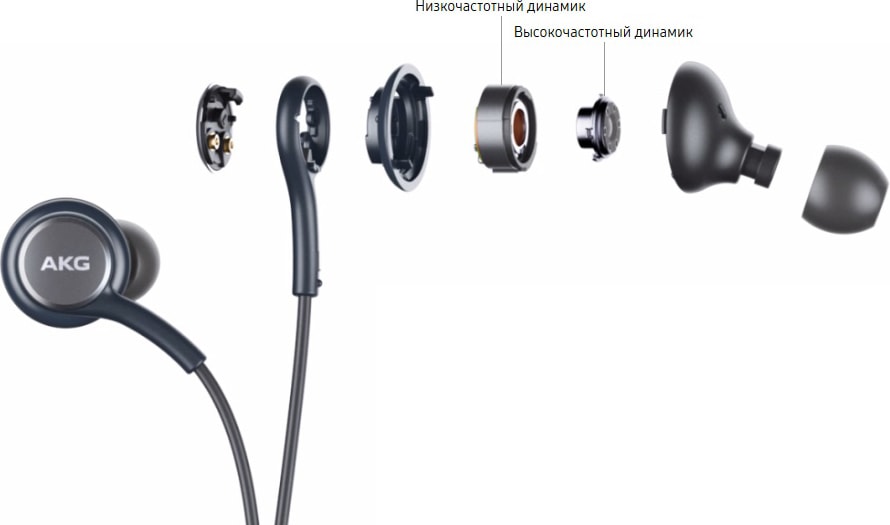

Summary
The main and most noticeable change in the new product is how much space the screen began to take up. He began to take up more space than ever. At the same time, the dimensions of the phone did not become much larger - only the height (length) increased.
No one will notice the increase in subpixel resolution without a microscope, so this change is not so significant. If we take the usual model (not Plus), then the appearance of a curved screen will also be significant.
The next significant change follows from the previous one - this is the transfer of the fingerprint scanner from the front to the back, which in itself is rather a minus.
More productive hardware, but this does not seem to be a very significant innovation.
You may find the Bixby Assistant helpful. Apparently, Samsung is betting heavily on this.
The smartphone, due to how much space the screen takes up, plus due to the fact that the screen is rounded, it immediately shows others that this is the flagship and the flagship of 2017. Those who like to show off expensive things will like it. After all, some flagships can be confused with more simple models, but in this case it will be difficult to do.
If the screen area to the size of the phone is not such a significant indicator for you, then it makes sense to buy the seventh generation, and not the eighth. The price, by the way, for the seven after the appearance of the eight should be lower.
It can be assumed that the model without the Plus prefix will become more fashionable. The trick is that Samsungs with curved screens were larger than their direct counterparts - S6 Edge, S6 Edge +, S7 Edge, Note Edge. And now you can have such a curved screen both on a larger phone and on a smaller one.
If you want a not too big device and still want stylish and expensive rounded edges of the screen, then you will have to fork out for a "regular" Samsung Galaxy S8.
Color
Deciding on the type of device (phone or smartphone?) is quite simple. If you need a simple and inexpensive device for calls and SMS, it is recommended to stop the choice on the phone. A smartphone is more expensive, but it offers a wide variety of options: games, videos, the Internet, thousands of programs for all occasions. However, its battery life is significantly less than that of a regular phone.General characteristics
Type
MST (Magnetic Secure Transmission) is a technology that allows you to pay by phone with an attached bank card even on those terminals in the store that do not support contactless payments. The phone, using the built-in induction loop, emulates the rental of a card in the terminal. Glossary of terms for the category Mobile phones
yes Weight 155 g Dimensions (WxHxT) 68.1x148.9x8 mmScreen
Screen type color AMOLED, touch Touch screen type multi-touch, capacitive Diagonal 5.8 inches. Curved screen is Image size 2960x1440 Number of pixels per inch (PPI) 568 Automatic screen rotation eat scratch resistant glass eatMultimedia features
Rear camera 12 MP Flash rear, LED Rear camera functions autofocus, optical stabilization Rear camera aperture f/1.7 Video recording eat Max. video resolution 3840x2160 Max. video frame rate 30 fps Front-camera yes, 8 million pixels. Audio MP3, AAC, WAV, WMA Headphone jack 3.5mmConnection
Standard
There are several basic standards cellular communication which are supported by modern phones. On the territory of Russia, the GSM standard is used almost everywhere. For high-speed data transmission, 3G and 4G LTE standards are used - the highest speed of existing standards. Glossary of terms by category Mobile phones
GSM 900/1800/1900, 3G, 4G LTE, LTE-A Cat. 16 VoLTE Interfaces
Almost all modern smartphones have Wi-Fi and USB interfaces. Slightly less common are Bluetooth and IRDA. Wi-Fi is used to connect to the internet. USB is used to connect your phone to a computer. Many phones also have Bluetooth. It is used to connect wireless headphones, to connect your phone to wireless speakers, as well as for file transfer. A smartphone equipped with an IRDA interface can be used as a universal remote control remote control. Glossary of terms for the category Mobile phones
Wi-Fi 802.11ac, Bluetooth 5.0, USB, ANT+, NFC satellite navigation
Embedded GPS modules and GLONASS allow you to determine the coordinates of the phone from signals from satellites. In the absence of GPS, a modern smartphone can determine its own location based on signals from base stations. mobile operator. However, finding coordinates from satellite signals is usually much more accurate. Glossary for the category Mobile Phones
GPS/GLONASS/BeiDouMemory and processor
CPU
IN modern phones and smartphones usually use special processors - SoC (System on Chip, system on a chip), in which, in addition to the processor itself, graphics core, memory controller, I / O device controller, etc. Therefore, the processor largely determines the set of functions and performance of the device. Glossary for the Mobile Phones category
Qualcomm Snapdragon 835 MSM8998 Number of processor cores 8 Video processor Adreno 540 Built-in memory
Built-in memory is used to store programs, music, photos, movies. The amount of built-in memory largely determines the cost of the device. If your phone does not have a memory card slot, then it is recommended to choose a model with a large amount of built-in memory.
64 GB Volume random access memory 4 GB Memory card slot
Memory cards allow you to expand your phone's memory. They can be used to store programs, music, photos, movies. Usually SD cards (SDHC, SDXC) are used. If your phone does not have a memory card slot, then it is recommended to choose a model with a large amount of built-in memory.
yes, up to 256 GB (combined with a slot for a second SIM card) eatAdditional Information
Roskachestvo rating 4.541 RAW support yes smartphone, USB Type-C cable, AKG headphones, Sim eject tool, charger, USB connector, Micro USB connector Peculiarities audio - support for UHQ 32-bit Corning Gorilla Glass 5; Dual Pixel technology; Gigabit LTE, Gigabit Wi-Fi; Processor: Qualcomm Snapdragon 835 or Samsung Exynos 8895 depending on the market, graphics accelerator: Adreno 540 or Mali-G71 MP20 depending on the processor; waterproof - IP68 Announcement date 2017-03-29 Sales start date 2017-04-21Check before buying specifications and complete set from the seller
Finally, we all have lived to the point where the design set by the first generation iPhone back in 2007 has evolved. The time of faceless bricks, which 99.99% of all modern smartphones now look like, is over! And the first device of the next round of development is the Samsung Galaxy S8.
Look at new samsung Galasy S8 and its older brother in the face of the Galaxy S8 +. Do they look like at least one of the currently existing smartphones?
Personally, I do not recall any such a cool-looking device. Yes, it was introduced last year. He was great! On renders where it really seemed frameless.

However, in real life still, a small, but still not gone anywhere, side along the perimeter of the screen was found. In S8, this is not the case - the smartphone screen is rounded and flows somewhere beyond the boundaries of the smartphone. One gets the impression that the display comes to the back of the device, but this, of course, is not the case.
So, right from the doorstep, we began to discuss the main feature of the device - a 5.8-inch screen with a fierce resolution of 2960 by 1440 pixels. The dot density is simply off scale - 570 dpi. I must say that in terms of the last parameter, the youngest bypasses his older brother S8 +. Here the density of dots per square inch is 529 dpi, and the screen diagonal is 6.2 inches. The resolution in both devices is the same and is cleverly referred to as Quad HD+. We remember the new term, then we trump it with the owners of outdated iPhones from all sides.

By the way, this resolution is another step towards improving the quality of the picture in VR headsets. Not a leap, of course, but already something in the way of getting rid of the terrible pixelation in virtual reality headsets.
The difference in the diagonals of the screens could not but affect the dimensions, so this parameter may be critical for someone. Take a look at the comparison table below to get an idea of how spade-shaped the new items are…
| Length | Width | Thickness | Weight | |
| Samsung Galaxy S8 (5.8'') |
148,9 |
68,1 |
||
| Samsung Galaxy S8+ (6.2'') |
159,5 |
73,4 |
||
| iPhone 7 (4.7'') |
138,3 |
67,1 |
||
| iPhone 7 Plus (5.5'') |
158,2 |
77,9 |
||
| Huawei Mate 9 (5.9'') |
156,9 |
78,9 |
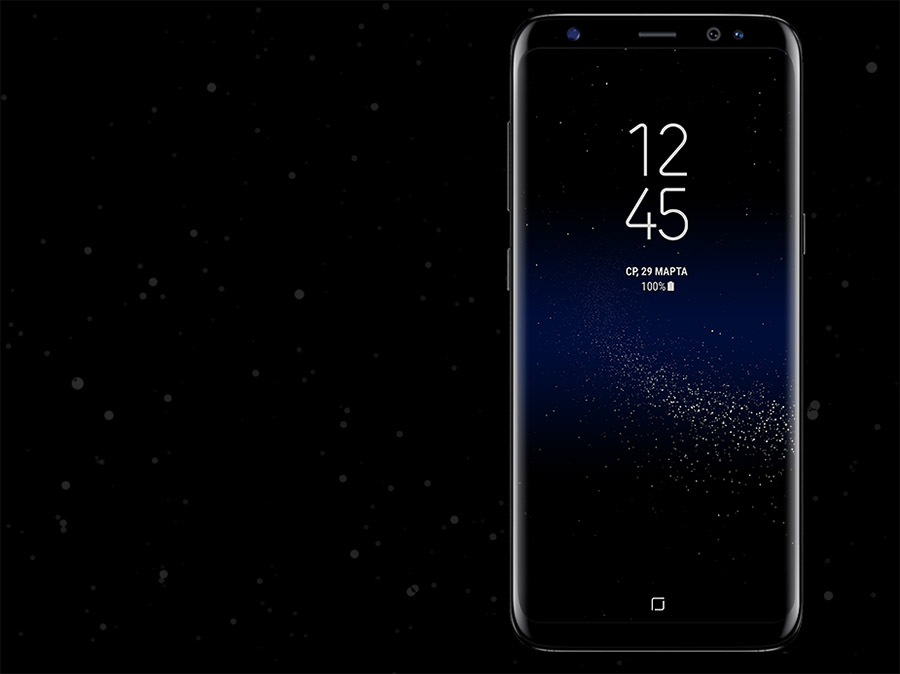
By the way! Since the display is “limitless” (as the company calls it), there was no place for a physical home button at the bottom. All buttons are now on-screen. Many hate this approach, but the guys from Samsung assured that everything is implemented in a smart way. When needed, they are there; when not needed, they are not. Well, you have to actually check it out.
Just presented in New York, the novelties are the first in the world among mobile devices received an Exynos 9 processor (model 8895), created using a 10-nanometer process technology in-house. Depending on the region, the devices will receive either a chip of their own production or a Qualcomm Snapdragon 835. We, the inhabitants of Russia, will rejoice at the performance of the South Korean processor.

In addition, the "stone" includes a modem with support for LTE Cat. 16, which will allow you to download data from the network at speeds up to 1 gigabit. Absolute record to date. It remains only to find such a cellular coverage - a trifling matter!
Most fans of the brand have high hopes for the cameras of the device. The release of the next revision of the Galaxy raises the bar of quality mobile photography and this is the rule. So far, we have only numbers and promises, but I am sure that this year there was no exception. So, the "eight" received an 8-megapixel front camera with a record f / 1.7 aperture for this module and autofocus. Samsung calls it intelligent, apparently, it can detect faces in the frame, gender, age, amount of money in the bank, and so on.
A 12-megapixel sensor with the same f / 1.7 aperture and Dual Pixel technology is installed at the back - more light enters each point on the matrix. And yes, the camera no longer sticks out and this is perhaps one of the coolest achievements. I'm serious!

Another indisputable advantage of gadgets from the South Korean giant is the security provided by the Knox platform. Now the device can be protected not only with a PIN code, a fingerprint, but with a unique "pattern" of one's own iris. A special Iris scanner is installed on the front of the smartphone, which scans the iris, and at the same time recognizes the owner by his characteristic facial features.
If anything, the fingerprint sensor has moved to the back cover of the smartphone. In general, this is not very convenient, but we have Always On Display and an Iris scanner, so you won’t have to touch the smartphone again.
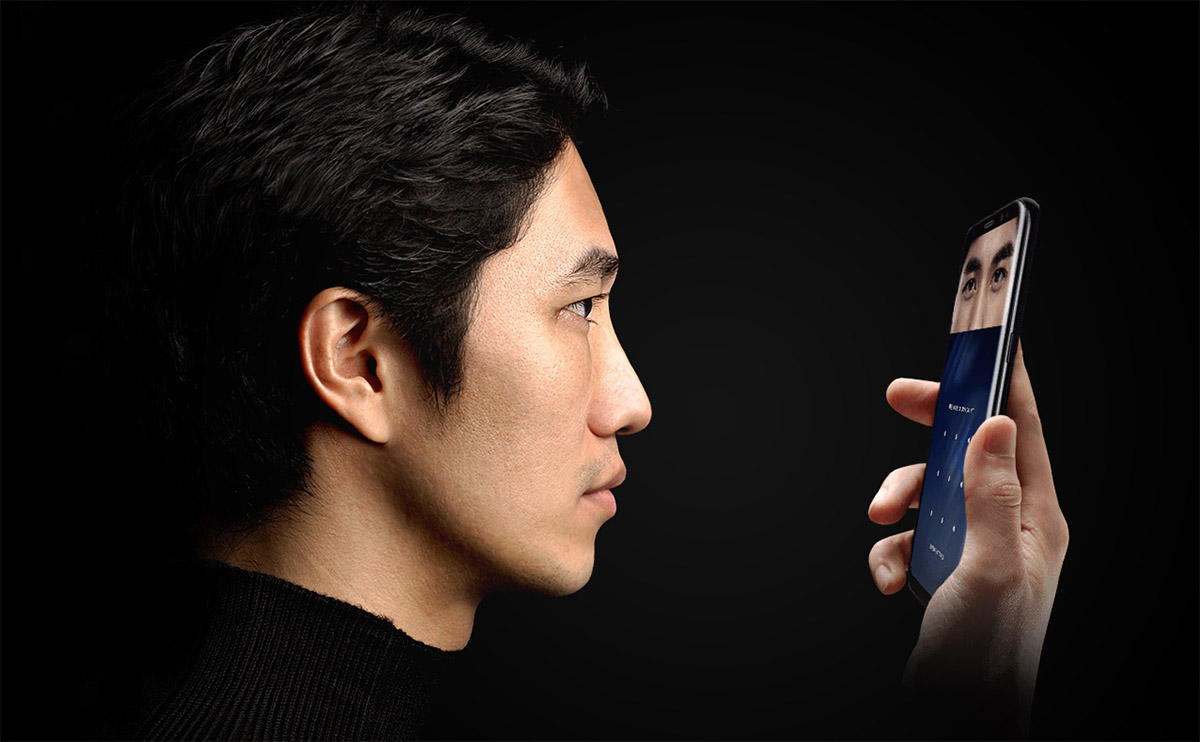
The novelty will also mark the release of another chip - the intelligent assistant Bixby. This is not just a competitor to Siri or Cortana (although it is not a competitor to anyone at all), it is a system integrated into the OS and user behavior. The assistant evaluates what you do on your smartphone, how you do it, where, when, and helps you make certain decisions, helps you search for what the user needs, and so on. Another attempt to create something similar to AI, which, of course, at first will be terribly stupid. However, it is better to try to do something than just sit back.
Bixby in Russia will be presented a little later. When - while no one can say, but support must be.
Of course, such chips as:
- protection against moisture and dust according to IP68 standard
- Samsung Pay wireless payments
- support for Micro SD cards up to 256 GB (with the release of S6 and S6 Edge, the manufacturer scared people, so now this option is highlighted separately)
- BB charging support (fast and wireless)

The 3.5mm audio jack is still there. It is gratifying that the Samsung developers are friends with the head and left the port untouched. Nearby, that is, on the lower end, there is also USB Type-C. In the last generation there was Micro USB, but now, apparently, they felt that the time had come.
Technical samsung specifications Galaxy S8(model SM-G950) And Galaxy S8 Plus (SM-G955) is best compared by pushing both devices head-on. Let's get started.

As seen, differences between Samsung Galaxy S8 and S8+ not very much. The "flattened" version bigger screen and battery. There are no other differences.

Since the giant Harman is now owned by Samsung, it's not a sin to pack your top-end device with normal headphones. In the kit, future owners will be able to find a two-driver headset from AKG (“daughter” of Harman). "Inimitable sound quality", noise reduction, advanced cable braid - everything is in place.

I'm sure you're already itching to know "when?" and "how much?". I answer! Start of sales of Samsung Galaxy S8 and Galaxy S8 + in Russia scheduled for the second half of April. To be more precise, it will be April 28, 2017. However, those who ordered and paid for the novelty on the official website will receive their devices before this date. And they will also get a gift in the form of a 360-degree samsung cameras gear 360.



Initially, three colors will be supplied: black, amethyst (something between pink and purple) and gold.


Later there is a chance that two more colors will be added: silver and blue ( Galaxy Note 7, hello!).
Well, the most interesting thing is the prices. Buy Samsung Galaxy S8 it will be possible for 54,990 rubles, and the older modification, that is, the Galaxy S8 + will be sold for 59,990 rubles. The prices are higher than the direct competitor in the face and 7 Plus. On the other hand, you put both of these competitors side by side. Well?! I hope everything is clear?
| Regional modifications | ||
|---|---|---|
| China, USA and Japan | International version | |
| Chipset | Samsung Exynos 8895 Octa | |
| CPU | 4 x Kryo 280 @ 2.45 GHz 4 x Kryo 280 @ 1.90 GHz | 4 x Exynos M2 @ 2.3 GHz 4 x ARM Cortex-A53 @ 1.7 GHz |
| GPU | Adreno 540 @ 650 MHz | ARM Mali G71 MP20 @ 550 MHz |
| RAM | 4 Gb LPDDR4x @ 1866 MHz 6 Gb LPDDR4x @ 1866 MHz * |
|
| Flash | 64/128 Gb UFS 2.1 | |
| microSD | Yes, up to 256 Gb, hybrid slot (for Duos models) | |
| Screen | 5.8 inches WQHD+ (1440 x 2960 pixels), Super AMOLED, Multitouch, Edge, ~570 ppi pixel density, ~83.6% of the total smartphone front area | |
| Screen protection | Corning Gorilla Glass 5 | |
| Always-on display | Yes | |
| Main camera | 12 Mp, f/1.7 aperture, 26 mm focal length (35 mm film equivalent), phase detection autofocus, optical image stabilization, LED flash, 4K video recording, video + photo simultaneously | |
| Front-camera | 8 Mp, f/1.7 aperture, 22mm focal length (equivalent), 2K video recording, dual video call, Auto HDR | |
| Connection | 2G/3G/4G | |
| GSM | Yes ** | |
| UMTS | Yes ** | |
| LTE | Yes ** | |
| CDMA | No | |
| CDMA2000 | yes (only SM-G9500, SM-G950V, SM-G950R) | No |
| TD-SCDMA | yes (only SM-G9500) | No |
| 4G LTE speed | Download: LTE Category 16, up to 1 Gbps (!) Transmission: LTE Category 13, up to 150 Mbps |
|
| Dual-SIM | SM-G9500 only | yes (not all modifications) |
| WiFi | 802.11 a/b/g/n/ac, dual-band 2.4/5 GHz, Wi-Fi Direct, up to 867 Mbps | |
| Bluetooth | v5.0 | |
| Navigation | GPS + A-GPS, GLONASS, Beidou, Galileo, QZSS, SBAS | |
| NFC | Yes | |
| Samsung Pay | yes (NFC + MST) *** | |
| Radio | No | |
| USB | v3.1, Type-C 1.0, OTG | |
| 3.5 mm audio | Yes | |
| The fingerprint scanner | yes (on the back of the case to the right of the camera) | |
| IRIS scanner | yes (frontal) | |
| Face recognition | yes (front camera) | |
| Sensors | Accelerometer, gyroscope, distance sensor, compass, barometer, heart rate and oxygen saturation sensors | |
| fast charging | Quick charge 3.0 | Yes |
| Wireless charger | PMA | Qi/PMA |
| Protection IP68 | Yes | |
| Battery | 3000 mAh non-removable | |
| OS | Android 7.0 Nougat | |
| shell | Samsung TouchWizUI | |
| Voice Assistant | Google Assistant, Bixby (not all regions yet) | |
| Dimensions | 148.9 x 68.1 x 8.0mm | |
| Weight | 155 g | |
* Modification with 6 Gb of RAM is currently only available in China and South Korea
** The set of supported frequencies and sub-versions of the standard may vary depending on the country or mobile operator(for operator versions).
*** Samsung Pay contactless payment service is not yet available in all countries.
Specifications of the Samsung Galaxy S8 Plus, different from the basic version
Below are the technical specifications of the Galaxy S8 Plus, which differ from the original version without a “plus”.
And now in detail
CPU
It is, of course, a key component that determines the rest of the characteristics of the Samsung Galaxy S8. As before, Koreans prefer to “keep their eggs in two baskets”, for this reason the smartphone is available in versions with different chipsets – Exynos 8895 of its own design and Qualcomm Snapdragon 835.

This year there was a very interesting turn, yet noticed by far not everyone. New generation mobile processors performance is slightly superior to the previous one. The main focus of the manufacturers this time was on such characteristics as data transfer speed in mobile and wireless networks, support for dual cameras, etc.

More about Snapdragon comparison 835 and Exynos 9 Series (8895) can. We only note here that both chipsets are approximately equal in their technical capabilities, and to a greater extent it is worth worrying about debugging the software.
Memory
Contrary to expectations, the “eighth galaxy” turned out to be a little more modest in terms of memory characteristics, but this almost always happens with top models, from which a “mega-breakthrough” is expected.
RAM
Most of the Samsung Galaxy S8 and Galaxy S8+ have 4 GB of fast dual-channel LPDDR4x RAM with clock frequency 1866MHz. It is believed that this is quite enough for a comfortable launch of modern mobile applications.
However, specifically for China and South Korea, Samsung will produce an “extended” edition of the Galaxy S8, which has as much as 6 Gb of RAM. Apparently, this is due to active competition from local vendors from China, especially Xiaomi with its Mi6.
Built-in storage
The new Samsung Galaxy S8 is available in versions with 64 and 128 Gb of built-in flash memory. The latter is still as rare as the version with 6 Gb of “RAM”. The most modern and high-speed UFS2.1 chips are used.
Some sources also indicated an option with a drive with a capacity of as much as 256 Gb. However, in view of the possibility of expansion, Samsung its production in general.
Expandability
Like last year's Galaxy S7, new Galaxy S8 allows you to expand the internal storage by installing a microSD memory card. The controller built into the chipset allows the use of fast modern SD 3.0 (UHS-I) cards.
Officially supported cards are up to 256 Gb, but in practice, nothing prevents you from using SDXC as large as possible - 2 Tb.
It should be noted that thanks to the OTG option, you can also connect external USB drives with a USB Type-C interface, as well as more traditional USB 1.1 / 2.0 / 3.0 - through an adapter.
Screen
The Galaxy S8 display is perhaps the key feature of Samsung's new flagship. In the process of creating the device, the company's specialists decided that it was time to do away with the classic forms and offer something radically new. Moreover, competitors have noticeably perked up in this direction, which is worth only one.

Samsung screen Galaxy S8 has grown significantly compared to last year's Galaxy S7 - a diagonal of 5.8 inches versus 5.1, and also became wider. At the same time, the dimensions of the smartphone remained almost the same. For the sake of this, we had to abandon such a familiar hardware button “Home” and additional touch control keys on the sides of it.

Thanks to this solution, the flagship display occupies almost 85% of the frontal surface, the frames are left only at the top and bottom. The fingerprint scanner has moved to the back of the case. This solution is often found in Chinese manufacturers and will be quite familiar to many.
Of course, most of the freed up space will be occupied by on-screen controls, but in games and other full-screen applications, Galaxy S8 owners will be able to fully enjoy the benefits of a large diagonal.
And this time, Samsung will equip all modifications of its flagship with a curved screen like the Galaxy S7. Thus, the Edge prefix will lose its relevance, and the concept will become mainstream.
Another feature of the Galaxy S8 and S8 Plus is the ability to change the screen resolution. It defaults to 1440 x 2960 pixels (WQHD+), but can be downgraded to FullHD+ (1080 x 2220) or HD+ (1480 x 720) for better performance and battery life.
Camera
Contrary to expectations, Samsung did not equip the Galaxy S8 double cam. Instead, the smartphone received an updated 12-megapixel sensor for the main module with DualPixel technology already familiar to us from the Galaxy S7.


The first test shots taken by the main Galaxy camera S8 show vibrant colors and high quality images. Of course, only “field tests” will show the real possibilities of photography, but now we can say with full confidence that the new Samsung flagship- one of the best camera phones of 2017.

In the case of the front camera, the Koreans also did not chase the number of megapixels, as they like to do now in Podneesnaya. Its resolution is quite modest - 8 Mp, but the quality of the "selfie" is much superior to Chinese competitors.
Connection
The new flagship Samsung has excellent support for modern mobile networks, however, the specific list of frequencies and cellular standards varies among different regional and carrier models.
So, Chinese (SM-G9500) and some American versions(SM-G950V, SM-G950R) can work in CDMA2000 1xEV-DO networks, TD-SCDMA is also available in China (a purely local 3G standard, not relevant in other countries).

Thanks to the new X16 modem, Galaxy S8 is able to download data in 4G networks at speeds up to 1 Gbps (if the operator has equipment that meets the requirements of LTE Category 16).
A significant part of smartphones has support for two SIM-cards. Usually sellers in such cases add the prefix Duos. However, this does not apply to American carrier versions, which are traditionally tied to native networks.
As noted above, the dual-SIM Galaxy S8 has a hybrid tray that allows you to install either two nano-SIM SIM cards, or one SIM card and MicroSD.
Communications
In terms of communication capabilities The Galaxy S8 is literally packed to the brim. The only thing missing is FM radio and an infrared port for controlling external devices.
Bluetooth
The Galaxy S8 is the first smartphone to support Bluetooth 5.0. The fifth version of this multifunctional standard wireless communication increases the range of the transmitter by as much as four times, and the speed - by two.

In addition to traditional features like file transfer and sharing mobile internet Bluetooth 5.0 provides enhanced control capabilities for a variety of wearable gadgets. Lately this direction is becoming more and more popular.
WiFi
Even this, in general, “gentleman's” option modern smartphone Like a WiFi connection, the Samsung Galaxy S8 is in line with the latest high-tech trends. The smartphone has a dual-band (2.4 + 5 GHz) adapter wireless networks IEEE 802.11 a/b/g/n/ac.
The maximum data transfer rate is 867 Mbps (with an appropriate access point or WiFi router). Of course, there is support for Wi-Fi Direct and hotspot mode.
Navigation
It would seem that ever since smartphones have gained GPS support It is very difficult to come up with something new in this direction. However, the Galaxy S8 provides previously unavailable navigation options.
So, in addition to the standard A-GPS, GLONASS and Beidou, the smartphone can use satellites of the European Galileo system, as well as QZSS, SBAS correction to more accurately determine the coordinates.
USB
Finally, almost two years behind, Samsung has equipped the flagship Galaxy line S instead of the old-fashioned microUSB 2.0 with the modern “full-bodied” USB port Type-C 1.0, data transfer rate complies with the USB v3.1 standard.

The connector is used in the Galaxy S8 to synchronize data with a PC, charge and connect external OTG devices. Older devices with USB 1.1/2.0/3.0 will require an appropriate adapter.
NFC and Samsung Pay
"Eighth Galaxy" has full support for Samsung Pay branded contactless payment service, including both MasterCard PayPass/VISA PayWire and magnetic tape emulation using MST technology. However, to use it, it is necessary that the service be available in your country, and the smartphone itself must be officially purchased in its territory.
At the same time, the NFC adapter can work with any other contactless payment applications, such as QIWI, Yandex.Money, Mobile Wallet, Beeline Card, TCS mobile banks, Sberbank online, Privat24 (Ukraine), etc.
Sensors
The fingerprint scanner of the Samsung Galaxy S8 has moved from the mechanical home button (which is no longer there at all) to the back of the case - to the right of the main camera. Its location is perhaps one of the few controversial points of the new flagship - when unlocked, it is easy to leave a greasy imprint on the lens.
The fault is most likely the desire of Koreans to be different from the countless Chinese smartphones, which has a round fingerprint sensor on back cover. And embedding it under the screen turned out to be too expensive and technically difficult.
But the Galaxy S8 has a frontal iris scanner. It was supposed to be popularized last year's Galaxy Note 7, however, due to the explosiveness, Samsung had to discontinue the product altogether and recall the entire circulation if possible.
From a set of other sensors, it is worth noting the presence of an accelerometer, a gyroscope, a distance sensor, a barometer, pulse meters and blood oxygen saturation levels.
Audio
Samsung has never really focused on the musical capabilities of its flagships. We can only say one thing - they always sounded great. Those who needed to listen loudly to tracks on a smartphone without headphones, and even a stereo with “good” bass, purchased more affordable “youth” devices.
According to rumors, the Galaxy S8 has a very decent DAC from C-MEDIA, which means you don’t have to worry about the sound quality. In addition, the Koreans did not, unlike Apple and Lenovo, throw out the usual 3.5 mm jack. So the owners of the new “galaxy” will be spared from inconvenient adapters and the need to search for special headphones.
Battery and Power
Like its predecessor, the Samsung Galaxy S8 received a built-in 3000 mAh battery. In view of the non-removable design and the fact that the smartphone has a sealed waterproof case, it is recommended to replace it only at an authorized service center.

The device potentially supports fast charging using Quick Charge 4.0 technology, which allows you to charge it in 5 minutes for as much as four hours of use. In 15 minutes, the gadget's battery is replenished by 50% with complete zero. The only requirement is the presence of an appropriate charger (included).

Has not gone anywhere and has received its development and support wireless charging in accordance with the Qi and PMA standards, which has become even faster (but does not compare with wired yet).
Software
Despite having its own Tizen mobile OS, Samsung continues to use in its Android flagships in view of the huge popularity among users and developers, as well as the presence of a huge number of applications in the store Google Play.
Operating system
The Samsung Galaxy S8 runs under relatively up-to-date today android versions 7.0 Nougat.
For at least the next couple of years, the gadget should receive up-to-date updates to new versions of the mobile OS from Google, as well as firmware from the manufacturer.
Samsung Bixby voice assistant
One of the important features of the new flagship from South Korea is a “smart” voice assistant called Bixby. It is based on the developments of Viv Labs, which once created Siri, a similar solution for Apple devices.
The new assistant Viv Labs introduced in May 2016. The still raw product was highly acclaimed by both IT experts and ordinary users. Not surprisingly, Samsung soon simply acquired the company with all the developments in the field of artificial intelligence and speech recognition.
According to ETnews, Bixby already supports 7-8 languages (including Chinese and Korean), while the built-in latest versions android google Assistant - only 4. When support for the Russian language appears - it is not yet known.
It is reported that third-party developers can release their own extensions for the new voice assistant Galaxy S8.
P.S. For now, Bixby is only available in South Korea. Everyone else will have to be content with Google Assistant for the time being.
Dimensions, etc.
According to data published on the network from manufacturers of accessories (primarily covers), Samsung dimensions The Galaxy S8 is 148.9 x 68.1 x 8.0 mm (159.5 x 73.4 x 8.1 mm in the case of the Galaxy S8+), which is quite consistent with the notion of a “classic” smartphone.
For lovers of the Samsung brand, another holiday has come, two beautiful smartphones will appear on sale at once - Samsung Galaxy S8 and Galaxy S8+. Being followers of the Galaxy S7 and direct competitors to the Apple iPhone 7, both devices are worthy of their owners. User friendly design and the powerful filling of the Galaxy S8 is impressive, which is worth talking about in more detail.
Design and interface
Touch and swipe, pinch and spread fingers - all this is part of the properties of the touchscreen interface. Change of applications is improved by 3D Touch technology, which distinguishes between the force of finger pressure (Peek, Pop). The entire electronic component is enclosed in a durable glass case, and the display accounts for 5.8 inches diagonally. The front panel almost entirely belongs to the screen, the edges of which are rounded even on the side edges. A small strip is left on top, on which you can see the eye of the main camera at 12 megapixels and the double flash LED. The rear panel has an 8-megapixel front camera, a flashlight and a biometric scanner. Below is the branded inscription of the brand. By color scheme Samsung Galaxy S8 will be available in only three variants: dark black, orchid gray and silver. But even this choice is quite enough not to miss the moment of purchase.
The novelty of the device is the use DeX docking stations connected with a USB Type-C cable. The appearance of additional HDMI outputs and two USB ports greatly expand the functionality of the gadget as a PC. Another useful assistant is the Bixby option - a voice command assistant.
Operating room and more
The Android platform, even the latest generation, is somewhat different in content from the "apple" indicators of iOS, at some points even surpassing its competitor. The proprietary processor (for Russia) is represented by the Exynos 8895 brand, for the US it will be replaced by Snapdragon 835 from Qualcomm. According to its main parameters, it is designed for 4 GB of RAM, while the main one will not exceed 64 GB. Expansion via microchip 128/256 GB is allowed. Responsibility for graphic support rests with the Mali G71 accelerator, which is quite enough for high-quality images not only text information but also photos and videos. Performance is also possible due to the presence of universal Flash Storage, and with the built-in Generation of the second version.





